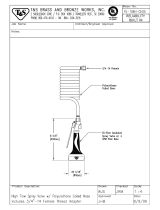
Component List – 157594P.1
15
REF PART # DESCRIPTION Model QTY REF PART # DESCRIPTION Model QTY
783394 Honda engine 18hp All 1 58 777721 Decal, side panel All 2
1
783396 Honda muffler kit All 1 59 777647 Battery box All 1
2 30511 1/2” npt plug All 1 60 777489 Battery strap All 1
3 777837 3/8” npt plug All 1 61 82233 Carriage bolt, 5/16” threads All 2
4 38198 CAT pump, 4gpm All 1 62 KEL201071 Cap, fuel tank All 1
5 777347 3/8” npt tee All 2 63 777727 Tank, Diesel All 1
6 777378 Hose, 18" 5400psi All 2 64 783029 Gasoline tank All 1
7 777682 Pressure gauge, 6000psi, 1/4” npt All 1 65 783034 Tank support All 1
8 777338 Reducer 3/8” npt x 1/4” npt MxF All 3 66 777838 1/4” NPT plug 157594 2
9 777410 Elbow 3/8” npt MxF All 3 67 781999 Thermostat All 1
10 17141 Hose clamp 3/4 hose All 4 68 777855 Toggle switch All 1
11 30289 Clear PVC hose, 3/4” All 12.5in 69 31085 Circuit breaker, 20A All 1
12 777671 Hose barb 1/2” npt M x 3/4”hose All 1 70 777644 Control box cover All 1
13 778829 Hose barb elbow 3/4npt M x 3/4hose All 1 71 777646 Red LED, 12VDC All 2
14 250142 Strainer, 3/4” npt FxF All 1 72 777660 Decal, control panel All 1
15 780413 Nipple 3/4” npt x 3/4” npt MxM All 1 73 777643 Control box panel All 1
16 39206 Tee 3/4” npt MxFxF All 2 74 36138 Relay 12VDC All 1
17 35442 Ball valve 3/4” npt FxF All 2 75 777645 Hose barb 1/2” npt F x 1/2” hose 157594 1
18 5023 Hose barb 3/4” npt x 3/4” hose All 1 76 305267 Nut, 1/2” npt 157594 2
19 35443 Elbow 3/4” npt x 3/4” npt MxM All 1 77 30483 Garden hose inlet, 1/2" npt M 157594 1
20 82220 U-bolt All 2 78 5232 Washer, garden hose 157594 1
779269 Elbow 3/4” npt M x 1/2” HB 157594 1 778946 Nozzle 0 degree #4, red All 1
21
780432 Elbow 3/4” npt M x 3/4” HB 157595 1 25309 Nozzle 15 degree #4, yellow All 1
777119 Hose clamp 1/2” hose 157594 5 778948 Nozzle 25 degree #4, green All 1
22
17141 Hose clamp 3/4” hose 157595 2 778947 Nozzle 45 degree #4, white All 1
2264 Low pressure hose, 1/2” 157594 27in
79
778949 Nozzle, chemical, black All 1
23
30289 Clear PVC hose, 3/4” 157595 67in 80 777111 Grommet, nozzles All 5
24 779268 Hose barb 3/4” npt M X 1/2” hose All 1 81 38578 Knob, 5/16” thread All 2
25 2264 Low pressure hose, 1/2” All 7in 82 30289 Clear PVC hose, 3/4” All 40in
26 30048 Reducer 1/2” npt x 3/8” npt MxF All 2 83 22393 Relief valve, 3/8” npt All 1
27 32808 Elbow 3/8” npt M x 1/2” HB All 1 84 38379 Swivel, 3/8” npt x 1/2” npt MxF All 1
28 777340 Hose barb 1/4” npt M x 1/4” hose All 3 85 5027 Elbow, 1/2” npt MxF All 1
29 38584 Easy start valve, 3/8” npt M All 1 86 777652 Lid w/ rain cap All 1
30 777834 Hose clamp 1/4” hose All 9 87 305410 Decal, caution hot All 1
31 777165 Clear PVC hose, 1/4” All 12" 88 36302 Fiberglass rope, 5/8" All 39in
32 782123 Unloader All 1 89 38398 Insulation, cap All 1
33 777337 Nipple 1/2” npt x 3/8” npt MxM All 3 90 779228 Heating coil All 1
34 777409 Unloader block All 1 305278 Heat shrink tube
All
2in
35 777656 Pressure switch All 1
91
30501 Split loom
All
24in
36 777411 Tee 3/8” FxFxF All 2 92 305208 Tee 1/2” npt FxFxF All 1
37 777667 Battery cable, red All 1 93 777915 Quick couple nipple, 3/8” npt F All 1
38 777668 Battery cable, black All 1 94 779614 Injector, quick couple All 1
39 31881 Reflective sleeve All 14in 95 777165 Clear PVC hose, 1/4” All 48in
40 777345 Fuel line, 1/4” All 42in 96 221222 Strainer, chemical hose All 1
41 35743 Warning label All 1 97 777661 Wire harness, burner All 1
42 35413 Drain valve All 1 98 22502 Strain relief All 1
43 30746 Hose clamp 3/8” hose All 1 99 777669 Burner DC All 1
44 30290 Clear PVC hose, 3/8” All 14in 100 777345 Fuel line, 1/4” All 22in
45 777836 Thermal protector, 1/2” npt All 1 101 777345 Fuel line, 1/4” All 15.5in
46 777904 Quick coupler, 1/4” npt F All 1 102 32308 Fuel filter, water separator All 1
47 777421 Spray lance All 1 103 305239 Nipple 1/4” npt MxM 3" long All 1
48 777420 Spray gun All 1 104 38120 Insulation gasket All 1
49 777422 Quick coupler, 3/8” npt M All 1 105 36180 Stainless wrap All 1
50 777396 Hose, 50ft 5400psi, includes 51+52 All 1 106 779232 Fire chamber All 1
51 777722 Quick coupler, 3/8” npt F All 1 107 33387 Insulation, can All 1
52 777723 Quick couple nipple, 3/8” npt F All 1 108 783036 390cc carbon canister All 1
53 777475 Skid frame 157594 1 109 783037 Carbon canister strap All 1
54 777488 Heat shield, tanks All 1 110 784769 Sealed fuel cap All 1
55 777486 Heat shield, battery All 1 111 783218 Purge port cap All 1
56 783035 Tank clamp All 1 112 783212 1/4” MPT hose barb elbow All 2
57 777666 Decal, gasoline All 1
113 777345 Fuel line, 1/4”
All 37”























